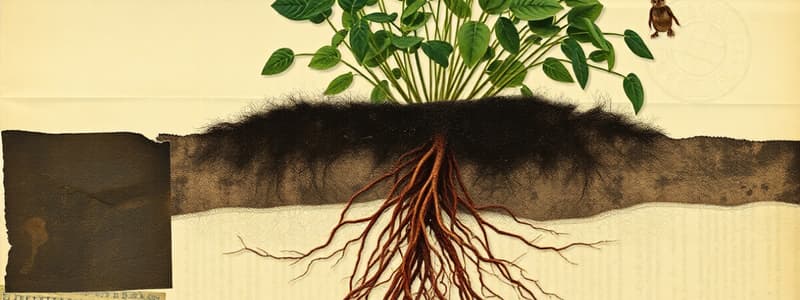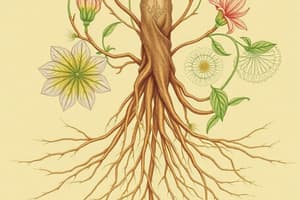Podcast
Questions and Answers
What is the primary role of the root system in plants?
What is the primary role of the root system in plants?
- To produce food through photosynthesis
- To support the plant above ground
- To store food for future use
- To absorb water and nutrients from the soil (correct)
Which type of root system is characterized by a single large root that grows straight down?
Which type of root system is characterized by a single large root that grows straight down?
- Fibrous root system
- Creeping root system
- Taproot system (correct)
- Shallow root system
What is the function of stomata in leaves?
What is the function of stomata in leaves?
- To absorb nutrients from the soil
- To facilitate gas exchange (correct)
- To store water
- To provide structural support
Which structure of the leaf connects it to the main stem?
Which structure of the leaf connects it to the main stem?
How do stems contribute to a plant's survival?
How do stems contribute to a plant's survival?
Which of the following types of plants typically has a fibrous root system?
Which of the following types of plants typically has a fibrous root system?
What is the primary function of leaves in a plant?
What is the primary function of leaves in a plant?
Which part of the stem provides support and stability to help the plant remain upright?
Which part of the stem provides support and stability to help the plant remain upright?
What is the main function of flowers in plants?
What is the main function of flowers in plants?
Which statement correctly explains the structure of a seed?
Which statement correctly explains the structure of a seed?
What are two essential conditions required for seed germination?
What are two essential conditions required for seed germination?
Which type of seed has one cotyledon?
Which type of seed has one cotyledon?
What is one way to ensure the health of plants?
What is one way to ensure the health of plants?
What role does manure have in plant care?
What role does manure have in plant care?
What did Jagadish Chandra Bose contribute to the study of plants?
What did Jagadish Chandra Bose contribute to the study of plants?
Which type of root system consists of many small, branching roots?
Which type of root system consists of many small, branching roots?
Flashcards are hidden until you start studying
Study Notes
Parts of a Plant - Structure and Function
- Plants are made up of two primary parts: the root system and the shoot system.
- The root system anchors the plant and absorbs water and nutrients from the soil.
- There are two main types of root systems: taproot systems and fibrous root systems.
- Taproot systems have a single, large main root that grows straight down with smaller roots branching off. Examples include radish, carrot, mustard, and bean plants.
- Fibrous root systems are made up of a bunch of small, branching roots that grow outward from the plant. Examples include grass, rice, wheat, and onion plants.
- Roots also store food in some plants, such as beetroots, carrots, radishes, and turnips.
- The shoot system is the part of the plant that grows above ground and contains the stem, branches, leaves, fruits, and flowers.
- Stems provide support, allow leaves to reach sunlight, carry food from leaves to the rest of the plant, and carry water and nutrients from roots to leaves.
- Different types of stems include soft or hard, weak or strong, and can be classified by their structural features.
- Stems can also store food in some plants, such as potatoes, ginger, and sugar cane.
Leaves
- Leaves come in various shapes and sizes, with examples including large leaves on banana plants, small leaves on tulsi plants, heart-shaped leaves on peepal trees, and round leaves on lotus plants.
- Some leaves have toothed edges, like those found on rose and hibiscus plants.
- The leaf blade is the flat part of the leaf.
- The midrib is the main vein running through the leaf blade.
- Veins are thin tubes branching out from the midrib and carry water and minerals.
- The petiole is the stem that connects the leaf to the main stem or branch.
- Stomata are tiny holes on the underside of leaves, allowing air to enter and water to exit.
- Leaves are the site of photosynthesis and are responsible for converting sunlight, water, and carbon dioxide into food using chlorophyll.
- Leaves also release oxygen into the atmosphere as a byproduct of photosynthesis.
Flowers, Fruits, and Seeds
- Flowers are the most beautiful part of the plant and play a key role in reproduction, as well as attracting pollinators.
- Flowers can be a source of food in some plants, like broccoli and cauliflower.
- Fruits develop from flowers and contain seeds.
- Seeds contain an embryo (baby plant) and a food store called cotyledons.
- The seed coat protects the seed.
- Germination is the process of a seed growing into a new plant, requiring water, air, and warmth.
- Roots emerge first during germination, followed by the shoot.
- Monocots have one cotyledon and store food in parts of the seed other than the cotyledon, while dicots have two cotyledons and store food within the cotyledons. Examples of monocots include maize, rice, and grass, while examples of dicots include pea, bean, and grains.
Care of Plants
- Plants are vital to all living beings, providing food, oxygen, medicine, timber, rubber, and other essential resources.
- Plants need regular watering, protection from extreme temperatures, sunlight for photosynthesis, and nutrients from the soil, often supplied through manure, for optimal growth.
Protection Against Insects and Diseases
- Insects and diseases can harm plants.
- Agricultural scientists recommend using insecticides or pesticides to control pests.
Jagadish Chandra Bose
- Jagadish Chandra Bose (1858-1937) was a pioneer in plant physiology, making significant contributions to the understanding of plant responses to stimuli.
- Bose was the first scientist to demonstrate that plants feel pain and affection.
- He invented the crescograph, an instrument that measures plant growth with high precision.
Studying That Suits You
Use AI to generate personalized quizzes and flashcards to suit your learning preferences.




